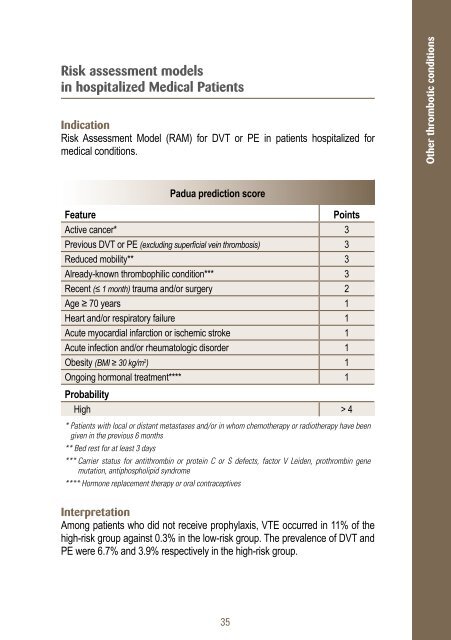Practical-Manual-Scores-Algorithms-Haemostasis-Thrombosis
Practical-Manual-Scores-Algorithms-Haemostasis-Thrombosis
Practical-Manual-Scores-Algorithms-Haemostasis-Thrombosis
Create successful ePaper yourself
Turn your PDF publications into a flip-book with our unique Google optimized e-Paper software.
Risk assessment modelsin hospitalized Medical PatientsIndicationRisk Assessment Model (RAM) for DVT or PE in patients hospitalized formedical conditions.Other thrombotic conditionsPadua prediction scoreFeaturePointsActive cancer* 3Previous DVT or PE (excluding superficial vein thrombosis) 3Reduced mobility** 3Already-known thrombophilic condition*** 3Recent (≤ 1 month) trauma and/or surgery 2Age ≥ 70 years 1Heart and/or respiratory failure 1Acute myocardial infarction or ischemic stroke 1Acute infection and/or rheumatologic disorder 1Obesity (BMI ≥ 30 kg/m 2 ) 1Ongoing hormonal treatment**** 1ProbabilityHigh > 4* Patients with local or distant metastases and/or in whom chemotherapy or radiotherapy have beengiven in the previous 6 months** Bed rest for at least 3 days*** Carrier status for antithrombin or protein C or S defects, factor V Leiden, prothrombin genemutation, antiphospholipid syndrome**** Hormone replacement therapy or oral contraceptivesInterpretationAmong patients who did not receive prophylaxis, VTE occurred in 11% of thehigh-risk group against 0.3% in the low-risk group. The prevalence of DVT andPE were 6.7% and 3.9% respectively in the high-risk group.35


